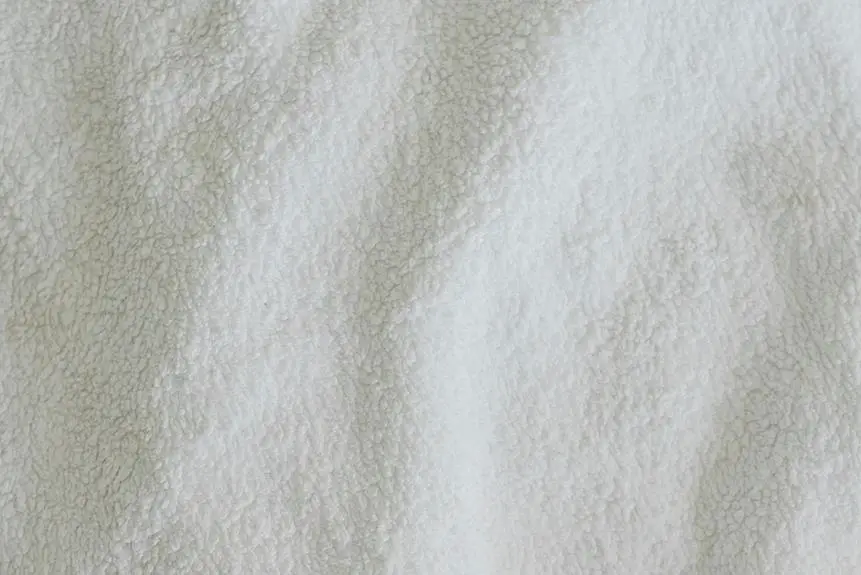When you're choosing between microfleece and cotton, it's crucial to consider each fabric's advantages and drawbacks. Microfleece is lightweight and excellent for insulation, which can be a game-changer during outdoor activities. However, it might not be as breathable as you'd like, and skin irritation can be a concern for some. On the flip side, cotton is known for its comfort and durability but struggles with moisture absorption and maintenance. So, which fabric really suits your needs? The answer might surprise you.
Table of Contents
Overview of Microfleece
Microfleece is a lightweight, synthetic fabric known for its softness and warmth, making it a popular choice for outdoor clothing and blankets. When you wear microfleece, you'll immediately notice how cozy it feels against your skin. This fabric traps warmth effectively without adding bulk, which is ideal for layering under jackets or wearing alone during milder temperatures.
One of the standout features of microfleece is its ability to wick moisture away from your body. Whether you're hiking, skiing, or simply lounging at home, this fabric helps keep you dry and comfortable. Its quick-drying nature means you won't be stuck in wet clothes for long, enhancing your outdoor experiences.
Furthermore, microfleece is typically machine washable, providing convenience for your busy lifestyle. You won't need to worry about special care instructions. Just toss it in the wash, and it's ready to wear again in no time.
However, it's important to note that while microfleece is durable, it's also prone to pilling over time. This can affect its appearance, so proper care is essential. Overall, microfleece offers an appealing blend of comfort and practicality for those who love outdoor activities.
Benefits of Cotton
Cotton offers a natural alternative to synthetic fabrics like microfleece, providing breathability and comfort that's perfect for everyday wear. One of the biggest advantages of cotton is its softness. You'll appreciate how gentle it feels against your skin, making it ideal for casual clothing, sleepwear, and bedding.
Another significant benefit is cotton's ability to wick moisture away from your body, which helps you stay dry and comfortable throughout the day. If you're participating in outdoor activities or exercising, you'll find that cotton can effectively manage sweat without sticking to your body.
Cotton is also known for its durability. With proper care, your cotton garments can withstand repeated wear and washing, maintaining their shape and comfort over time. Additionally, cotton is hypoallergenic, reducing the likelihood of skin irritations or allergic reactions, which is especially important for those with sensitive skin.
Lastly, cotton is biodegradable and more environmentally friendly compared to many synthetic fabrics. By choosing cotton, you're making a choice that supports sustainability while enjoying a versatile fabric that meets your daily needs.
Drawbacks of Microfleece
While it's cozy and lightweight, microfleece often struggles with breathability, making it less ideal for warmer weather or high-intensity activities. When you wear microfleece, you might find yourself feeling uncomfortably warm and sweaty, which can detract from your experience.
Microfleece has several drawbacks to consider.
Pilling: Microfleece can develop small balls of fabric on the surface over time, especially with frequent washing. This can make your gear look worn out, even if it's not very old.
Static Electricity: You might notice that microfleece tends to accumulate static cling, which can be annoying and uncomfortable. This can also lead to discomfort while wearing it under other layers.
Environmental Impact: Many microfleece products are made from synthetic fibers, which aren't biodegradable. This means they can contribute to environmental pollution, especially when they end up in landfills.
Downsides of Cotton
Though often regarded as a staple fabric, cotton has its own set of drawbacks that can impact comfort and performance in certain situations. One significant downside is its tendency to absorb moisture. When you're sweating or caught in the rain, cotton will soak up the moisture and take a long time to dry. This can leave you feeling damp and uncomfortable.
Another issue is that cotton is less breathable compared to synthetic fabrics, which can lead to overheating during active pursuits. Additionally, cotton clothing may shrink after washing, sometimes altering the fit of your favorite pieces.
Here's a quick comparison of cotton's downsides:
| Downsides | Impact on Comfort/Performance |
|---|---|
| Absorbs moisture | Can leave you feeling damp |
| Less breathable | May cause overheating |
| Shrinkage after washing | Alters the fit of clothing |
Considering these factors, it's crucial to evaluate your activities and environment when choosing cotton to ensure it meets your needs effectively.
Which Fabric to Choose?
When deciding between microfleece and cotton, consider your specific needs for comfort, warmth, and moisture management. Each fabric has its unique advantages, but your choice should align with how you'll use it.
- Climate & Activity: If you're in a cold environment or engaging in outdoor activities, microfleece is lightweight and provides excellent insulation while wicking away moisture. On the other hand, cotton is breathable and might be more comfortable for casual wear in milder weather.
- Care & Durability: Microfleece typically requires less maintenance than cotton. It's resistant to shrinking and fading, making it a reliable option for frequent use. Cotton, while soft and natural, may need more care to maintain its look and feel.
- Skin Sensitivity: If you have sensitive skin, you might prefer cotton as it's hypoallergenic and feels soft against the skin. Microfleece can sometimes cause irritation for some users, especially if worn for extended periods.
Frequently Asked Questions
Can Microfleece Be Recycled or Is It Environmentally Friendly?
Microfleece isn't easily recyclable, and its production can harm the environment. While it's warm and lightweight, consider its impact on sustainability. Opt for eco-friendly alternatives if you're concerned about waste and environmental effects.
How Do Microfleece and Cotton Compare in Terms of Price?
When it comes to price, microfleece is generally more affordable than cotton. However, you'll find variations based on brand and quality. Keep an eye out for sales to get the best deals on both.
What Are the Best Uses for Microfleece Outside Clothing?
Microfleece works great for blankets, pet beds, and outdoor gear. You'll love its lightweight warmth and moisture-wicking properties, making it ideal for camping, picnics, or just cozying up at home during chilly nights.
How Should I Care for Microfleece and Cotton Fabrics?
To care for microfleece and cotton, wash them on a gentle cycle in cold water. Avoid fabric softeners and high heat. Air dry or tumble dry on low to maintain their softness and durability.
Is Microfleece Recommended for Sensitive Skin?
Microfleece is generally soft and lightweight, making it suitable for sensitive skin. However, everyone's skin reacts differently, so try it out to see how your skin responds. It's always best to prioritize your comfort!
- How Does Ring Spun Cotton Affect Garment Fit and Shape Retention? - August 13, 2024
- What Are the Challenges in Producing Ring Spun Cotton? - August 13, 2024
- Is Ring Spun Cotton Suitable for Plus-Size Clothing? - August 13, 2024







